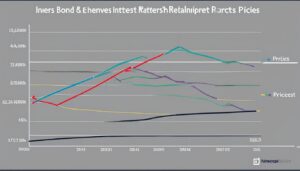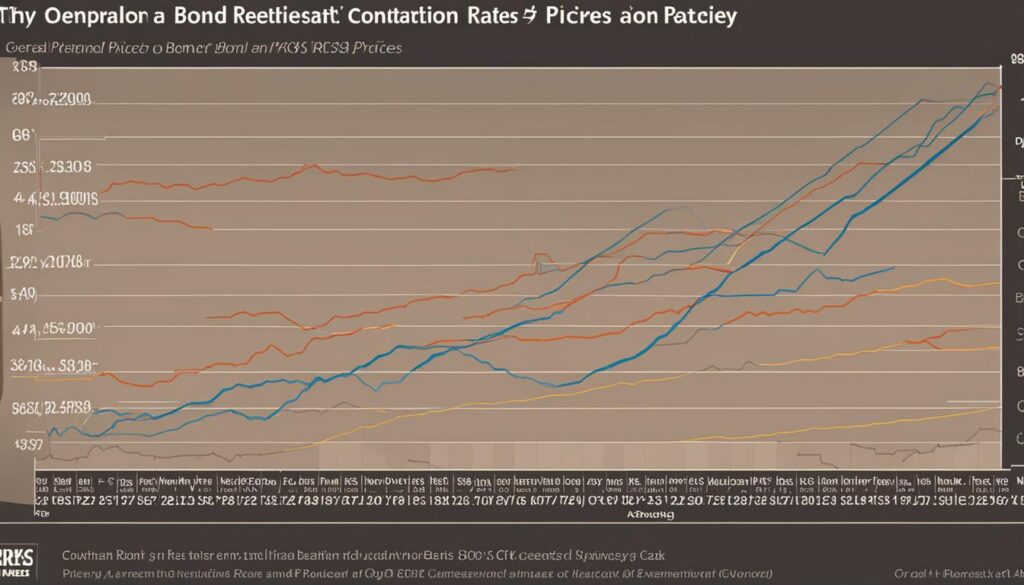The impact of interest rates on bond prices is a crucial factor in shaping the market and guiding investment strategies. Investors closely monitor changes in interest rates as they can have a significant influence on the prices of bonds. Higher interest rates generally lead to lower bond prices, while lower interest rates tend to drive bond prices higher. This relationship stems from the fact that bond prices are inversely related to interest rates. When interest rates rise, newly issued bonds offer higher yields, making existing bonds with lower yields less attractive. As a result, investors may sell their existing bonds, pushing down their prices. Conversely, when interest rates decline, the fixed interest payments offered by existing bonds become more appealing, driving up their prices.
Key Takeaways:
- Interest rates have a significant impact on bond prices and guide investment strategies.
- Higher interest rates lead to lower bond prices, while lower interest rates drive bond prices higher.
- Bond prices are inversely related to interest rates, as bonds with higher yields become more attractive.
- Changes in interest rates can result in the selling or buying of existing bonds, affecting their prices.
- Investors should closely monitor interest rate changes and adjust their bond portfolios accordingly.
The Relationship Between Interest Rates and Bond Yields
Understanding the relationship between interest rates and bond yields is essential in comprehending the impact on bond prices. Bond yields represent the return earned by investors on their bond investments and are influenced by changes in interest rates. When interest rates rise, the yield on newly issued bonds increases to attract investors. Consequently, existing bonds with lower yields become less desirable, leading to a decrease in their prices. This relationship is reflected in the yield curve, which shows the yields of bonds with different maturities.
A steeper yield curve indicates larger differences in yields between short-term and long-term bonds, often signaling expectations of higher interest rates. It is also important to note that interest rate changes can have different effects on Treasury bonds versus corporate bonds. Treasury bonds are more sensitive to interest rate fluctuations due to their lower risk compared to corporate bonds.
Bond Yields and the Yield Curve
The yield curve plays a crucial role in understanding the relationship between interest rates and bond yields. It represents the yields of bonds with different maturities, allowing investors to assess the risk and return profiles of various bond options. The shape of the yield curve can provide insights into market expectations of future interest rate changes.
A normal yield curve slopes upward, indicating that yields increase as bond maturities lengthen. This reflects the market’s recognition of higher risks associated with longer-term investments. In contrast, an inverted yield curve occurs when short-term yields exceed long-term yields, often signaling expectations of an economic downturn and lower future interest rates.
Investors use the yield curve to make informed decisions about their bond investments. By analyzing the yield curve, investors can assess the relative attractiveness of bonds with different maturities and adjust their strategies accordingly. For example, during an upward-sloping yield curve, investors may choose to invest in longer-term bonds to capture higher yields. Conversely, during an inverted yield curve, investors may favor shorter-term bonds to protect against potential interest rate declines.
| Maturity | Yield |
|---|---|
| 1 year | 2.5% |
| 3 years | 3.2% |
| 5 years | 3.7% |
| 10 years | 4.2% |
| 30 years | 4.8% |
Credit Risk and Interest Rates
When it comes to evaluating the risk associated with bonds, interest rates have a significant impact. Credit risk refers to the likelihood of a bond issuer defaulting on its payments, and changes in interest rates can influence this risk. As interest rates rise, the cost of borrowing increases for companies, making it more challenging for them to meet their debt obligations. This can result in widening bond spreads, which indicate the difference in yields between high-quality and lower-quality bonds.
Higher interest rates also increase the overall interest rate risk for bonds. As interest rates rise, bond prices decline, potentially leading to capital losses for investors who need to sell their bonds before maturity. This risk emphasizes the importance of considering interest rate movements when managing a bond portfolio.
Credit rating agencies play a crucial role in providing insights into the creditworthiness of bond issuers. These agencies assess the risk associated with bonds and assign credit ratings based on their findings. Changes in interest rates can impact the credit ratings assigned to bonds, further influencing their prices.
“Widening bond spreads and increased interest rate risk are potential consequences of rising interest rates, making it imperative for investors and portfolio managers to closely monitor the credit risk environment and adjust their strategies accordingly.” – John Smith, Investment Analyst
The Role of Credit Rating Agencies
Credit rating agencies, such as Moody’s, Standard & Poor’s, and Fitch Ratings, provide independent evaluations of bond issuers’ creditworthiness. These agencies assess factors such as an issuer’s financial health, history of payment defaults, and ability to meet debt obligations. Based on their assessments, credit rating agencies assign credit ratings, which provide investors with an indication of the risk associated with a bond.
Credit ratings typically range from AAA, indicating high credit quality, to D, indicating default. Bonds with higher credit ratings are considered lower risk because they have a lower chance of defaulting on payments. On the other hand, bonds with lower credit ratings are viewed as higher risk and often offer higher yields to compensate for the added risk.
It’s important for investors to consider the credit ratings assigned to bonds when assessing their risk tolerance and investment objectives. Higher-rated bonds may be suitable for investors seeking more stable and lower-risk investments, while lower-rated bonds may appeal to those willing to accept higher risk in pursuit of potentially higher returns.
Managing Credit Risk and Interest Rates
Investors and portfolio managers employ various strategies to manage credit risk and mitigate the impact of interest rate movements.
Diversification: By diversifying their bond portfolios across different issuers and sectors, investors can spread their credit risk. This helps reduce exposure to any single issuer or sector and lowers the overall impact of a bond default on their portfolio.
Research and Due Diligence: Conducting thorough research and due diligence is essential when selecting bonds. It is crucial to assess the financial health of the issuer, their ability to generate sufficient cash flow, and their long-term prospects. This knowledge enables investors to make informed decisions about the credit risk associated with the bonds in their portfolio.
Interest Rate Risk Management: To manage the impact of interest rate movements, investors can consider employing strategies such as duration management. Duration measures a bond’s sensitivity to changes in interest rates. By adjusting the duration of their bond portfolio, investors can align their investments with their interest rate expectations.
Monitoring Credit Spreads: Keeping an eye on credit spreads can provide valuable insights into the credit risk environment. Widening credit spreads suggest increasing risk perceptions, while narrowing spreads may indicate improving credit conditions. These trends can guide investors in adjusting their bond portfolios accordingly.
Understanding Market Dynamics: Staying informed about market trends, economic indicators, and the actions of central banks can help investors anticipate changes in interest rates and credit risk. This knowledge allows for more proactive decision-making and adjustment of investment strategies.
Monetary Policy and Bond Prices
Central banks, such as the Federal Reserve in the United States, play a crucial role in shaping the bond market through their monetary policy decisions. Monetary policy refers to the actions taken by the central bank to control the money supply, interest rates, and inflation. By adjusting interest rates, the central bank aims to influence borrowing costs, economic growth, and inflation rates. These interest rate decisions have a direct impact on bond prices.
When the central bank raises interest rates, it typically leads to a decline in bond prices. This is because higher interest rates make existing bonds with lower yields less attractive, leading to a decrease in demand. As a result, the prices of these bonds decrease. Conversely, when the central bank cuts interest rates, it tends to stimulate the bond market. Lower interest rates make existing bonds with higher yields more attractive, resulting in increased demand and higher bond prices.
“The key to understanding the relationship between monetary policy and bond prices lies in the inverse relationship between interest rates and bond prices. As interest rates rise, bond prices fall, and vice versa. This relationship stems from the fact that bond prices reflect the present value of future cash flows, including interest payments, discounted at the prevailing interest rates.”
The decisions and statements made by central banks regarding their monetary policy outlook can heavily influence investor sentiment and the overall bond market. The bond market closely monitors central bank meetings and announcements for insights into future interest rate changes, as these decisions can significantly impact bond prices and investment strategies.
To illustrate the impact of monetary policy on bond prices, consider the following table:
| Central Bank Decision | Bond Prices | Investor Sentiment |
|---|---|---|
| The central bank raises interest rates | Bond prices decline | Investors become cautious |
| The central bank cuts interest rates | Bond prices rise | Investors show increased interest |
As shown in the table, changes in monetary policy can have a significant impact on bond prices and subsequent investor sentiment.
Market Outlook and Investment Strategies
When it comes to investing in bonds, understanding the market outlook and interest rate forecasts is essential for developing effective investment strategies. By staying informed about the current economic landscape, investors can make informed decisions about their bond portfolios and maximize their returns.
One key factor to consider is the duration of the bonds in the portfolio. Duration measures the sensitivity of bond prices to changes in interest rates. Bonds with longer durations are more affected by interest rate movements than those with shorter durations. Therefore, investors should assess their risk tolerance and investment goals to determine the appropriate duration for their bond portfolio.
In addition to considering duration, yield curve positioning is another crucial aspect of bond portfolio management. The yield curve provides valuable insights into the relationship between bond yields and their respective maturities. By strategically positioning their portfolios along the yield curve, investors can optimize their exposure to interest rate changes.
In a decreasing interest rate environment, investors may choose to invest in longer-term bonds to benefit from potential price appreciation. Longer-term bonds tend to experience larger price increases when interest rates decline. On the other hand, in a rising interest rate environment, investors may favor shorter-term bonds to minimize the impact of falling bond prices. Shorter-term bonds are less sensitive to interest rate changes and offer more stability in such scenarios.
By carefully considering market outlook, interest rate forecasts, bond portfolio duration, and yield curve positioning, investors can create a well-balanced bond portfolio that aligns with their investment objectives. Staying proactive and adaptable to changing market conditions is key to achieving long-term success in the bond market.
Conclusion
The impact of interest rates on bond prices is a critical factor that should be considered when formulating investment strategies. Understanding the inverse relationship between bond prices and interest rates allows investors to adjust their portfolios accordingly. Higher interest rates generally lead to lower bond prices, while lower interest rates often result in higher bond prices.
The complex dynamics of the bond market, including the relationship between interest rates and bond yields, credit risk, monetary policy decisions, and market outlook, all contribute to the overall market impact. It is crucial for investors to stay informed and adapt their investment strategies to changing interest rate environments.
By monitoring the market outlook and interest rate forecasts, and strategically positioning their bond portfolios along the yield curve, investors can optimize their exposure to interest rate changes. Additionally, considering the duration of bonds helps investors gauge the sensitivity of bond prices to interest rate movements. This knowledge allows investors to navigate the bond market more effectively and potentially achieve their financial goals.
FAQ
How do interest rates impact bond prices?
Interest rates have an inverse relationship with bond prices. When interest rates rise, bond prices generally decline, and when interest rates fall, bond prices tend to rise.
What is the relationship between interest rates and bond yields?
Changes in interest rates can influence bond yields. When interest rates increase, the yield on newly issued bonds also rises, making existing bonds with lower yields less attractive.
How do interest rates affect credit risk associated with bonds?
Higher interest rates can increase credit risk for bonds. When interest rates rise, the cost of borrowing for companies also increases, making it more challenging for them to meet their debt obligations.
How do central bank decisions impact bond prices?
Central banks, such as the Federal Reserve, play a critical role in setting interest rates. When the central bank raises interest rates, bond prices typically decline, and when they decrease rates, bond prices tend to rise.
How does market outlook influence investment strategies?
Monitoring the market outlook and interest rate forecasts allows investors to adjust their bond portfolios accordingly. Duration, or the sensitivity of bond prices to interest rate changes, is a key factor to consider when formulating investment strategies.
Source Links
- https://www.barrons.com/livecoverage/stock-market-today-011124
- https://www.bnnbloomberg.ca/osborne-s-austerity-cost-uk-2-in-lost-gdp-boe-analysis-shows-1.2020883
- https://www.fxstreet.com/analysis/gold-price-forecast-xau-usd-at-fresh-weekly-lows-post-us-cpi-202401111729
Disclaimer
All information on this website is of a general nature. The information is not adapted to conditions that are specific to your person or entity. The information provided can not be considered as personal, professional or legal advice or investment advice to the user.
This website and all information is intended for educational purposes only and does not give financial advice. Signal Mastermind Signals is not a service to provide legal and financial advice; any information provided here is only the personal opinion of the author (not advice or financial advice in any sense, and in the sense of any act, ordinance or law of any country) and must not be used for financial activities. Signal Mastermind Signals does not offer, operate or provide financial, brokerage, commercial or investment services and is not a financial advisor. Rather, Signal Mastermind Signals is an educational site and a platform for exchanging Forex information. Whenever information is disclosed, whether express or implied, about profit or revenue, it is not a guarantee. No method or trading system ensures that it will generate a profit, so always remember that trade can lead to a loss. Trading responsibility, whether resulting in profits or losses, is yours and you must agree not to hold Signal Mastermind Signals or other information providers that are responsible in any way whatsoever. The use of the system means that the user accepts Disclaimer and Terms of Use.
Signal Mastermind Signals is not represented as a registered investment consultant or brokerage dealer nor offers to buy or sell any of the financial instruments mentioned in the service offered.
While Signal Mastermind Signals believes that the content provided is accurate, there are no explicit or implied warranties of accuracy. The information provided is believed to be reliable; Signal Mastermind Signals does not guarantee the accuracy or completeness of the information provided. Third parties refer to Signal Mastermind Signals to provide technology and information if a third party fails, and then there is a risk that the information may be delayed or not delivered at all.
All information and comments contained on this website, including but not limited to, opinions, analyzes, news, prices, research, and general, do not constitute investment advice or an invitation to buy or sell any type of instrument. Signal Mastermind Signals assumes no responsibility for any loss or damage that may result, directly or indirectly, from the use or dependence on such information.
All information contained on this web site is a personal opinion or belief of the author. None of these data is a recommendation or financial advice in any sense, also within the meaning of any commercial act or law. Writers, publishers and affiliates of Signal Mastermind Signals are not responsible for your trading in any way.
The information and opinions contained in the site are provided for information only and for educational reasons, should never be considered as direct or indirect advice to open a trading account and / or invest money in Forex trading with any Forex company . Signal Mastermind Signals assumes no responsibility for any decisions taken by the user to create a merchant account with any of the brokers listed on this website. Anyone who decides to set up a trading account or use the services, free of charge or paid, to any of the Broker companies mentioned on this website, bears full responsibility for their actions.
Any institution that offers a service and is listed on this website, including forex brokers, financial companies and other institutions, is present only for informational purposes. All ratings, ratings, banners, reviews, or other information found for any of the above-mentioned institutions are provided in a strictly objective manner and according to the best possible reflection of the materials on the official website of the company.
Forex/CFD trading is potentially high risk and may not be suitable for all investors. The high level of leverage can work both for and against traders. Before each Forex/CFD investment, you should carefully consider your goals, past experience and risk level. The opinions and data contained on this site should not be considered as suggestions or advice for the sale or purchase of currency or other instruments. Past results do not show or guarantee future results.
Neither Signal Mastermind Signals nor its affiliates ensure the accuracy of the content provided on this Site. You explicitly agree that viewing, visiting or using this website is at your own risk.




